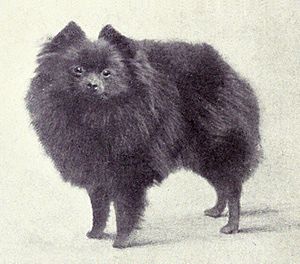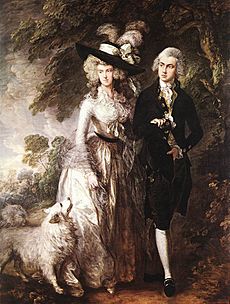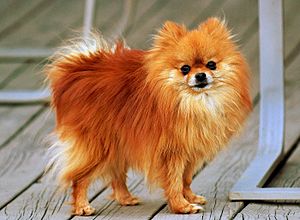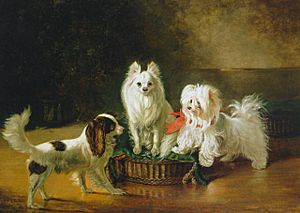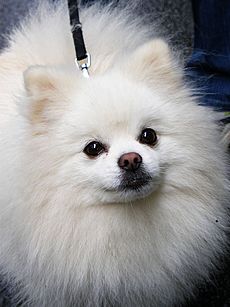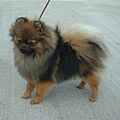Pomeranian (dog) facts for kids
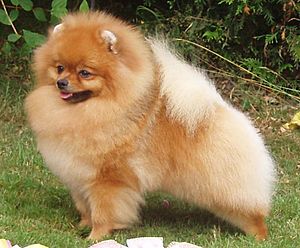 |
||||||||||||||||||||||||||
| Other names | Deutscher Spitz; Zwergspitz; Pom; Zwers | |||||||||||||||||||||||||
|---|---|---|---|---|---|---|---|---|---|---|---|---|---|---|---|---|---|---|---|---|---|---|---|---|---|---|
| Common nicknames | Pompom, Pom, Tumbleweed | |||||||||||||||||||||||||
| Origin | Germany (Pomerania) | |||||||||||||||||||||||||
|
||||||||||||||||||||||||||
|
||||||||||||||||||||||||||
| Domestic dog (Canis lupus familiaris) | ||||||||||||||||||||||||||
The Pomeranian, often called a Pom, is a small dog breed. It belongs to the Spitz type of dogs. This breed gets its name from the Pomerania region in Central Europe. This area is now part of north-west Poland and north-east Germany.
Pomeranians are known as toy dogs because of their tiny size. They come from larger Spitz-type dogs, especially the German Spitz. In many countries, they are called the Zwergspitz, which means "Dwarf-Spitz."
Many royal owners have helped make the Pomeranian popular since the 1700s. Queen Victoria owned a very small Pomeranian. Because of her, smaller Poms became very popular everywhere. During her life, the breed's size became half of what it used to be!
Pomeranians are usually strong and healthy dogs. Some common health issues they might have are problems with their kneecaps and windpipes. A rare skin condition called "black skin disease" can also affect them. This genetic problem makes their skin turn black and causes hair loss.
Since 1998, Pomeranians have been one of the top fifty most popular dog breeds in the US. Their popularity has grown even more around the world because small dogs are very trendy right now.
Contents
History of Pomeranians
Where Pomeranians Came From
The ancestors of today's Pomeranians were large working dogs. These dogs came from the cold Arctic regions. They are often called Wolfspitz or Spitz type dogs. The word "Spitz" is German for "sharp point." This name was first used in the 1500s to describe the shape of the dog's nose and muzzle. The Pomeranian is thought to be a descendant of the German Spitz.
The breed likely got its name from the Pomerania area. This region is in northern Poland and Germany, along the Baltic Sea. Even though the breed didn't start there, this area is where the original Pomeranian dog type was developed. We don't have many old records until the breed came to the United Kingdom.
One of the first mentions of the Pomeranian breed was on November 2, 1764. It was in a diary by James Boswell. He wrote, "The Frenchman had a Pomeranian dog named Pomer whom he was mighty fond of."
Royal Dogs
Two members of the British Royal Family helped change the breed. In 1767, Queen Charlotte, who was the wife of King George III of England, brought two Pomeranians to England.
These dogs were named Phoebe and Mercury. They were even painted by Sir Thomas Gainsborough. These paintings show dogs that were much bigger than modern Pomeranians. They reportedly weighed about 30 to 50 pounds (14 to 23 kg). But they had features like the thick coat, ears, and a tail curled over the back, just like Poms today.
Queen Victoria, who was Queen Charlotte's granddaughter, also loved Pomeranians. She started a large kennel for breeding them. One of her favorite dogs was a small red sable Pomeranian. Its name might have been "Windsor's Marco." This dog reportedly weighed only 12 pounds (5.4 kg).
When Queen Victoria showed Marco in 1891, the smaller type of Pomeranian became instantly popular. Breeders then started choosing only the smallest dogs for breeding. During her life, the size of the Pomeranian breed was said to have shrunk by half! Queen Victoria worked to make the Pomeranian breed better. She brought smaller Pomeranians of different colors from other European countries to add to her breeding program. Other royal owners during this time included Joséphine de Beauharnais, who was the wife of Napoleon I of France, and King George IV of England.
Pomeranians in Modern Times
The first club for the breed was started in England in 1891. The first rules for the breed were written soon after. The first Pomeranian was registered in America with the American Kennel Club in 1898. The breed was officially recognized in 1900.
In 1912, two Pomeranians were among only three dogs that survived the sinking of the RMS Titanic. A Pomeranian named "Lady" escaped with her owner in lifeboat number seven. Another Pomeranian was saved by Elizabeth Barrett Rothschild in lifeboat number six.
In 1926, a Pomeranian named Glen Rose Flashaway won the Toy Group at the Westminster Kennel Club Dog Show. This was the first Pomeranian to win a group at Westminster. It took until 1988 for a Pomeranian, "Great Elms Prince Charming II," to win the top prize, Best in Show, at the Westminster Kennel Club.
The Fédération Cynologique Internationale (FCI) published a standard in 1998. It includes the Pomeranian as part of the German Spitz standard, along with the Keeshond. The FCI standard says that "Spitz breeds are captivating" and have a "unique, cheeky appearance."
Appearance
Pomeranians are small dogs. They usually weigh between 3 and 7 pounds (1.36 to 3.17 kg). They stand about 6 to 7 inches (15 to 18 cm) tall at the shoulder. They are sturdy dogs with a thick, fluffy coat. Their tail is set high and curls over their back, looking like a plume of feathers.
The fur on their neck forms a "ruff," which Poms are famous for. They also have feathery hair on their back legs.
The first Pomeranians were white, or sometimes brown or black. In 1888, Queen Victoria got a small red Pomeranian. This made the red color very popular by the end of the 1800s. Today, Pomeranians come in more colors than almost any other dog breed! These colors include white, black, brown, red, orange, cream, blue, sable, black and tan, brown and tan, spotted, and brindle. They can also have combinations of these colors. The most common colors are orange, black, or cream/white.
The "merle" Pomeranian is a newer color developed by breeders. It's a mix of a solid color with lighter blue or gray patches. This gives the coat a mottled, spotted look. The most common base colors for merle are red/brown or black. Merle dogs can have blue eyes, and their nose and paw pads might be mottled pink and black.
Pomeranians have a thick, double coat. The outer coat is long, straight, and a bit rough. The undercoat is soft, thick, and short. Even though grooming isn't too hard, it's best to brush them daily. This keeps their coat healthy. They shed a lot, especially twice a year when their undercoat changes. Their fur can easily get tangled, so regular brushing is important.
Behavior
Pomeranians are usually friendly, lively, and playful dogs. They can sometimes try to act tough with other dogs or people. Pomeranians are very alert and notice changes around them. They might bark at new things, which can turn into a habit of barking too much. They also like to protect their home, so they might bark when they hear noises outside.
Pomeranians are smart dogs. They learn well from training and can be very good at getting what they want from their owners! They love being the center of attention. But if they aren't trained and socialized well, they can become bossy or stubborn. Using toys can help train Pomeranians to be comfortable spending time alone.
Health
Pomeranians usually live for 12 to 16 years. A well-cared-for Pomeranian with good food and enough exercise will likely have few health problems. If they stay a healthy weight, they are sturdy dogs. This breed has some health issues like other dogs, but some problems, like hip problems, are rare because Poms are so light.
Some health issues can happen if their teeth, ears, and eyes aren't cleaned regularly. With normal care, these problems can be avoided. Poms are prone to losing their teeth early, so dry food is often recommended. Pomeranians also have small litters, usually having between 1.9 and 2.7 puppies at a time.
Common Health Issues
Dogs with the "merle" coat color can sometimes have health problems. These can include mild to severe hearing loss, eye pressure issues, vision problems, and small or oddly shaped eyes. Merle dogs born from two merle parents might also have problems with their bones, heart, and reproductive system.
Luxating patella is another health issue in Pomeranians. This happens when the kneecap (patella) slips out of its normal place. The grooves in the knee that hold the kneecap might be too shallow. When the kneecap slips, the leg can lock up, and the dog might hold its foot off the ground. The first pain comes from the kneecap sliding. Once it's out of place, the dog usually doesn't feel pain from the slipped kneecap itself.
Tracheal collapse happens when the rings that keep the windpipe (trachea) open become weak and collapse. This closes the airway. Signs of this problem include a honking cough, like a goose sound. Dogs might also get tired easily, faint, or cough more in hot weather, during exercise, or when they're excited. This problem often gets worse as the dog gets older.
Pomeranians can get a condition often called "black skin disease." This is a mix of hair loss (alopecia) and skin darkening (hyperpigmentation). Other names for it include woolly coat or severe hair loss syndrome. This condition affects male Pomeranians more than females and can be passed down in families. Most dogs show signs after they become adults, but it can happen at any age. Other health problems can look like this condition, such as certain hormone issues or skin infections.
Exercise Needs
The Pomeranian is a small but energetic dog breed. They love getting lots of attention. Even though they are active, they don't need a huge amount of exercise. It's good to take them on several short walks each day and let them run around in a safe, fenced area.
Popularity of Pomeranians
The Pomeranian has been one of the most popular dog breeds in the United States. It has been in the top 20 of registered AKC dog breeds since at least 1998. In 2011, it was ranked #17, and in 2012 and 2013, it was #19. By 2017, it was ranked #22.
In the UK, it wasn't in the top 20 breeds in 2007 or 2008. In Australia, their popularity has gone down since 1986. In 1987, 1,128 Pomeranians were registered, but only 577 were registered in 2008. However, this was an increase from 2004, when only 491 dogs were registered. Pomeranians are considered the 27th most intelligent dog breed.
In 2008, Pomeranians were more popular in American cities. They were tied for tenth place in Detroit and Orlando. They were ninth in Los Angeles and tied for seventh in Seattle. But in Honolulu, they were the third most popular breed, behind only the Labrador Retriever and the German Shepherd.
Other pages
Images for kids
See also
 In Spanish: Pomerania (perro) para niños
In Spanish: Pomerania (perro) para niños


